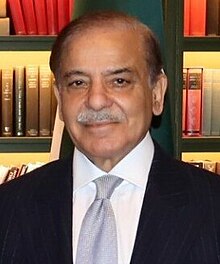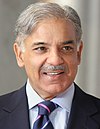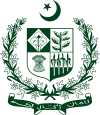Premiership of Shehbaz Sharif
This article needs to be updated. (March 2024) |
 | |
| Premiership of Shehbaz Sharif | |
President | |
|---|---|
| Party | Pakistan Muslim League (N) |
| Seat | Prime Minister's Office |
First term April 11, 2022 – August 14, 2023 | |
| Cabinet | First Shehbaz Sharif ministry |
| Election | 2022 |
Second term March 4, 2024 – present | |
| Cabinet | Second Shehbaz Sharif ministry |
| Election | 2024 |
|
| |
On 10 April 2022, Shehbaz Sharif was nominated as a candidate for Prime Minister of Pakistan by opposition parties following a vote of no confidence in incumbent prime minister Imran Khan during the 2022 Pakistani constitutional crisis.[1][2] He was sworn in as Prime Minister on 11 April 2022.[3][4]. Sharif remained in office until 14 August 2023, when he stepped down for a caretaker government to participate in the upcoming general election.[5] After a heavily contested election, Sharif was re-elected as Prime Minister on 4 March 2024, defeating the PTI-backed Omar Ayub Khan.[6]
Accession[edit]
After the 2022 Pakistan economic crisis led to political instability, the struggle was also joined by several dissident members of Khan's own party, Pakistan Tehreek-e-Insaf (PTI). On 10 April 2022, the coalition succeeded in ousting Khan through a no-confidence motion, after which the Pakistan Democratic Movement formed its own government, choosing the opposition leader Shehbaz Sharif as the country's prime minister.[7]
First administration (2022-2023)[edit]
Economic policy[edit]
The new government was faced with multiple economic challenges upon formation, mainly relating to the completion of the $6 billion IMF bailout program approved during Imran Khan's tenure. The government decided not to remove fuel and power subsidies imposed by Imran Khan during the last days of his tenure, viewing such a move as politically damaging to the new government. This was opposed by the Finance Ministry on the grounds that it could jeopardize the IMF program and increase the fiscal deficit.[8]
Foreign policy[edit]
The government immediately sought to mend ties with the United States that were strained by Imran Khan's Lettergate controversy, despite Washington's increasing prioritization of India over Pakistan in its foreign policy.[9] Experts believed the goal of this was to balance relations between the US and China, while also prioritising CPEC-related cooperation with China.[10] However, Pakistan has only received a limited response from the Biden administration,[11] the United States and India have also demanded that Pakistan stop cross-border terrorist activities.[12]
Political crisis[edit]
2022–2023 Pakistan political unrest continues, and clashes intensify after arrest of former PM Imran Khan.[13] Following the unrest, the Pakistani government supported the transfer of protesters to court-martial.[14]
2024 general election[edit]
Return of Nawaz Sharif[edit]
After serving 12 months of his 7-year sentence on corruption charges, former prime minister Nawaz Sharif left the country on 19 November 2019 to receive medical treatment in London, promising to return in 4 weeks. He was declared a fugitive in 2021 after failing to appear before courts despite summons. Nawaz obtained protective bail on 19 October 2023, which allowed him to return from 4 years of self-imposed exile without being arrested. On 21 October, he returned to the country, where he was welcomed in Lahore by a gathering of tens of thousands of his supporters.
On 9 January 2024, a seven-member Supreme Court bench under Chief Justice Qazi Faez Isa, hearing a review petition against lifetime disqualification, announced a 6–1 majority verdict with Justice Yahya Afridi dissenting. The verdict set aside the earlier Supreme Court interpretation of lifetime disqualification for article 62(1)(f) of the constitution, stating that it violated fundamental rights, and instead set a five-year disqualification following the newly passed laws for lawmakers who fail the moral standard of "sadiq and ameen" (honest and righteous). The timing of the verdict ensured that Nawaz, who was disqualified for life in the Panama Papers case in 2017, is eligible to contest these elections with a possible fourth term as prime minister.
PTI de facto ban[edit]
On December 22, 2023, the Election Commission of Pakistan ruled against allowing the PTI to retain its electoral symbol due to the party's failure to conduct intra-party elections to the commission's satisfaction. The PTI subsequently appealed to the Peshawar High Court, which suspended the ECP's order until January 9, 2024. However, following a review application by the ECP, the suspension was lifted by a two-member bench of the PHC, leading to a legal dispute resolved by the Supreme Court on January 11, 2024.
On January 13, a Supreme Court panel led by Chief Justice Qazi Faez Isa upheld the ECP's decision, reaffirming the denial of the PTI party's election symbol, the cricket bat. This ruling was based on the PTI's failure to hold intra-party elections in accordance with its constitution. Consequently, the PTI was unable to assign party tickets to its candidates, who were listed as independent candidates with individual symbols, and lost the right to nominate candidates for 226 reserved seats across central and provincial legislatures. Removing the cricket bat symbol was seen as a measure that could hinder voters from identifying the party on ballot papers, especially given Pakistan's high illiteracy rate of 40 percent.
See also[edit]
- Shehbaz Sharif ministry (Pakistan)
- Chief Ministership of Shehbaz Sharif
- List of international prime ministerial trips made by Shehbaz Sharif
References[edit]
- ^ "Pakistan to Vote in New PM as Ousted Khan Rallies Supporters". Bloomberg News. 11 April 2022.
- ^ Shahzad, Asif; Hassan, Syed Raza (11 April 2022). "Political change in Pakistan as Shehbaz Sharif seeks to become PM". Reuters – via www.reuters.com.
- ^ "Shehbaz Sharif, Pakistan Opposition Leader, Elected New PM". NDTV.com.
- ^ "Shehbaz Sharif elected prime minister of Pakistan". DAWN.COM. 11 April 2022. Retrieved 11 April 2022.
- ^ "Govt's tenure to end on Aug 14, says PM". dawn.com.
- ^ "Shehbaz Sharif elected Pakistan PM for second term after controversial vote". aljazeera.com.
- ^ Masood, Salman; Goldbaum, Christina (11 April 2022). "Shehbaz Sharif Becomes Prime Minister of Pakistan". The New York Times. Retrieved 12 April 2022.
- ^ Peshimam, Gibran Naiyyar; Shahzad, Asif (15 April 2022). "Pakistan's new govt decides not to roll back fuel, power subsidies". Reuters. Retrieved 1 July 2023.
- ^ Kestler-D'Amours, Jillian (15 April 2022). "What Pakistan's political shakeup means for relations with US". Al Jazeera. Retrieved 1 July 2023.
- ^ Zhou, Laura (11 April 2022). "Power shift in Pakistan won't affect China ties, 'hard-core friend' Beijing says". South China Morning Post. Retrieved 1 July 2023.
- ^ Hussain, Touqir (22 June 2023). "Does Pakistan really need Uncle Sam?". DAWN.COM. Retrieved 7 July 2023.
- ^ "Pakistan Rejects US, India Call to Curb Cross-Border Terrorism". VOA. 23 June 2023. Retrieved 7 July 2023.
- ^ Fraser, Simon; Davies, Caroline (9 May 2023). "Imran Khan: Dozens of police seize ex-PM outside court in Pakistan". BBC News. Archived from the original on 10 May 2023. Retrieved 9 May 2023.
- ^ Raza, Syed Irfan (13 May 2023). "Military rules out martial law". DAWN.COM. Retrieved 7 July 2023.




